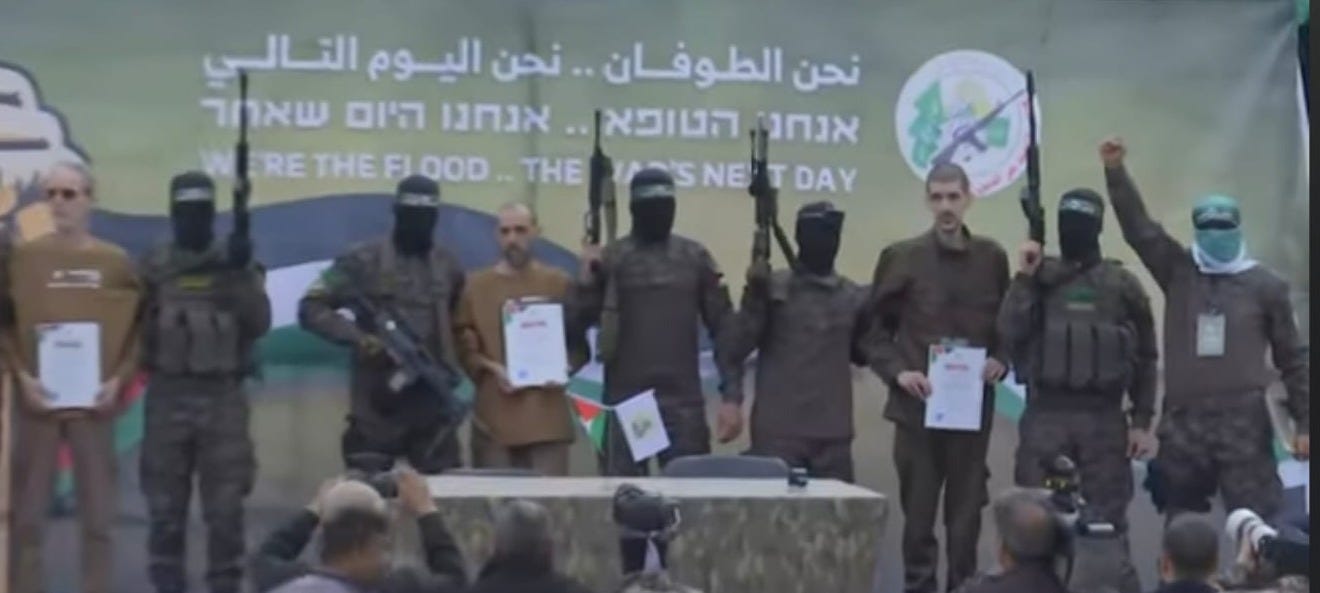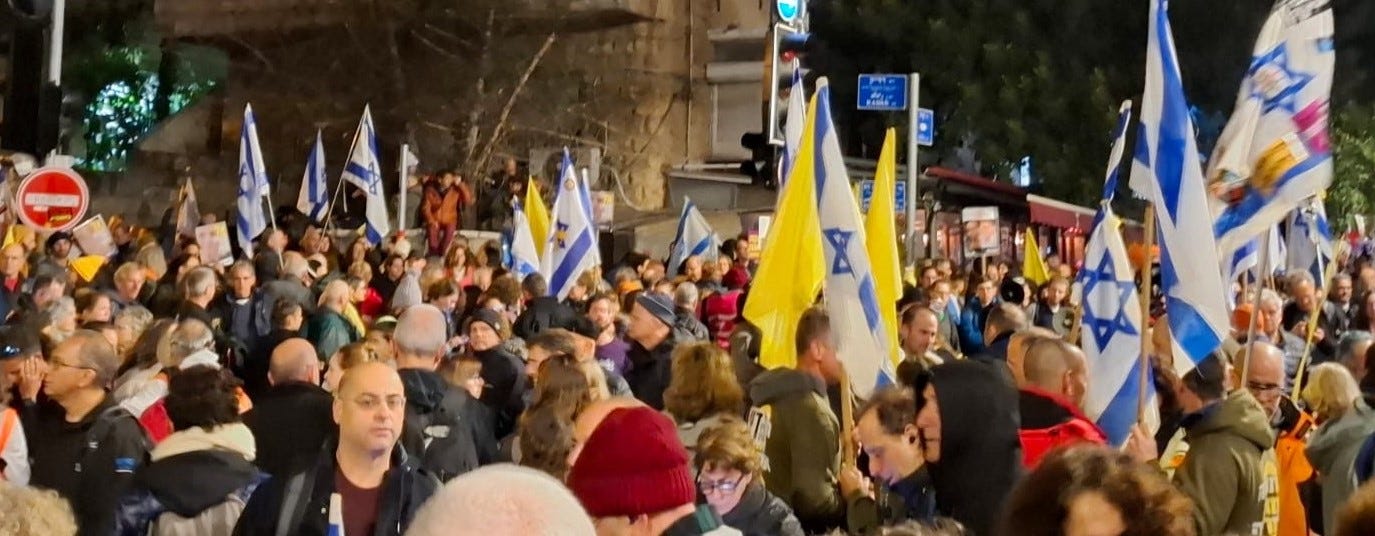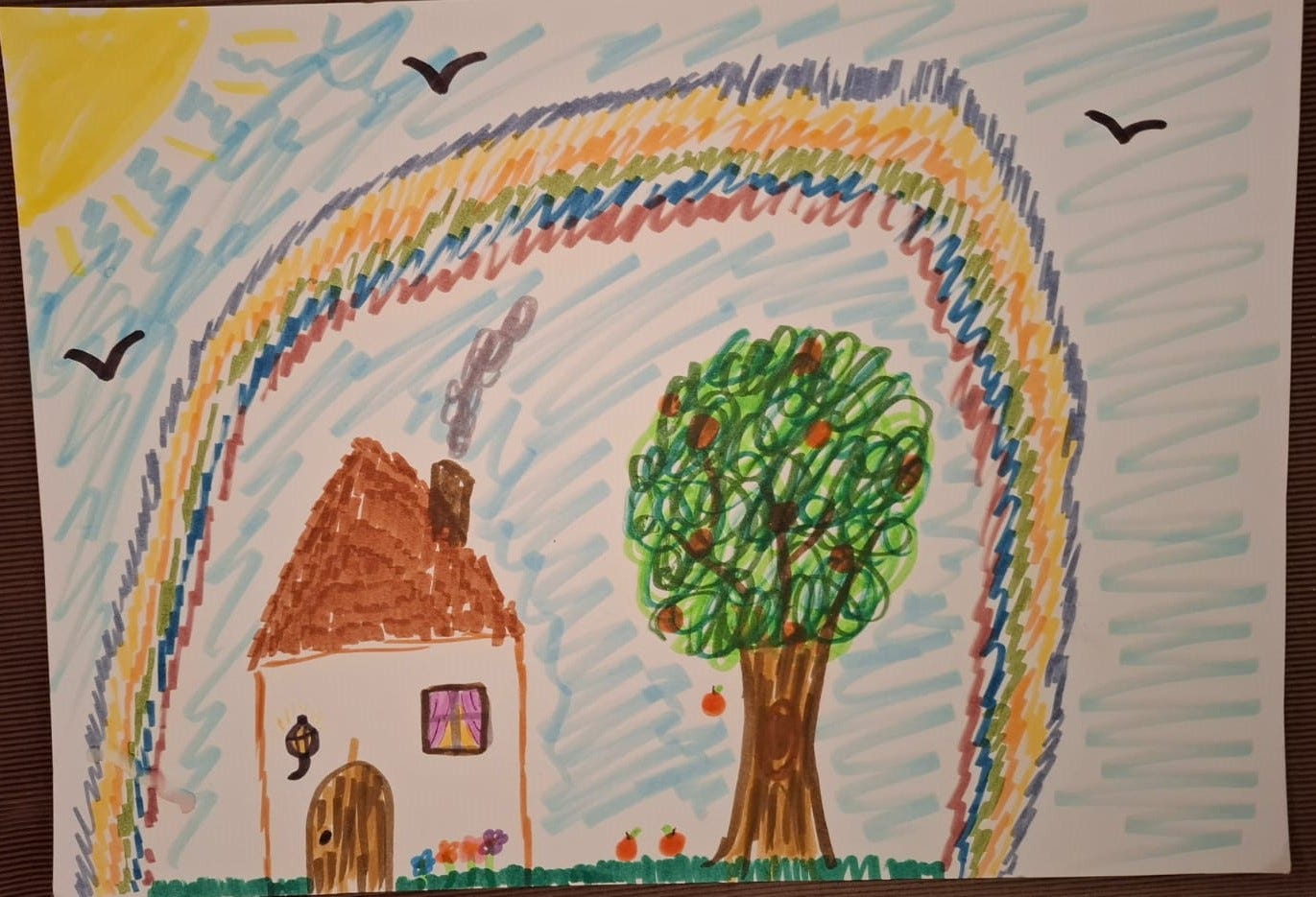As we are swept through the raging waters of recent weeks, my heart feels like a fisherman’s net. The catch is the flurry of unfolding events, each one heavier than the last, until the weight in my net-heart presses up hard against my lungs, and I must pause to take a deep breath because there is almost no air left.
With all of its emotional tumult, we have reached the end of Phase I of the hostage return-ceasefire-prisoner release deal. Now we are in freefall while the-powers-that-be decide what will be next, leaving all of us who live here dangling on a thread above a vast abyss.
Return
The return of the latest hostages has been a miracle, a tragedy, an accusation, profound grief over all that has happened to them, to us, and flashes of joy, all knotted together in one pulsing mass. Seeing each living hostage come back is like witnessing the dead rise up and return to the land of the living. And with each one who returns, the proportion of joy to grief varies, depending on their specific situation.
Consider Sagui Dekel-Chen, Or Levy and Eli Sharabi, who returned after almost 500 days in captivity, throughout which they had no idea if their wives and families had survived the October 7 massacre. Dekel-Chen was ecstatic to discover that his wife and daughters had not only survived, but that his wife had since given birth to their third. We are all buoyed, suspended even if only briefly, above the pain of so many of the others.
But then there’s Levy, who learned that his wife had been murdered in the same roadside bomb shelter where the two of them had taken refuge that day, along with our cousin Hersh and his best friend Aner. And Sharabi, who discovered that his wife and two daughters were murdered on October 7; adding to his grief for the news he had already heard: his brother, also abducted, is dead, his body still held by Hamas.
Each story of return hurtles us back to the horror of October 7th. Even as we try to shake off the trauma of that day, it is only more deeply embedded, like the fisherman’s hook sinking ever deeper into the fish wriggling to free itself once caught.
Levy, had spent some time in captivity with Hersh and immediately asked about him – only to learn of his execution. Sharabi too had met Hersh in captivity and both men said Hersh shared a mantra with them: “If you have your why, you will find your how.” It was a source of strength which helped them survive until they reached freedom.
This story, at least, is a precious gift, even as my joy for the returning hostages is streaked with grief that it will never be Hersh coming home to the grateful embrace of his family, friends and community.
Amid so much unbearable pain, is the fate of the Bibas family. Yarden, the young father, surviving captivity and abuse only to face the task of burying his beloved wife Shiri and their redheaded boys Ariel and Kfir. The video-taped kidnapping of a terrified Shiri trying to shield her toddler and baby as they were taken hostage became a symbol worldwide of the cruelty perpetuated October 7. Their recent return as corpses, the mix-up of Shiri’s body with an unidentified Palestinian woman’s, and reports that forensic assessments indicates that the children were killed with “bare hands” raised emotions to sky-high levels.
Their funeral was broadcast live, for we are all strands intertwined in this story that has thrust so many ordinary private citizens into the care of the public. I happened to flip on the radio just as Yarden was speaking. His heartbroken farewell filled the car, and tears streamed down my face. But I soon turned it off – it felt too personal and intimate, even if we are all, in a way, part of this story.
You can lose yourself in these stories, of the living and the dead, each one an ocean of pain. My fisherman’s-net-heart is almost shredded by the sharp edges, weight and bulk of so many stories, each a heavy stone.
Hamas manipulations
Hamas has mastered the art of exquisite manipulations of Israeli hearts. With each hostage handover Hamas orchestrates elaborate stages, backdrops and scripts. Central are the hundreds of Hamas fighters in military fatigues, black ski masks covering their faces, weapons strapped across their chests. Emerald green Hamas flags flutter in the wind.
They put up banners in Hebrew with slogans like “Nazi Zionism will not win;” “We’re the flood… we’re the day after.”

At one of the most recent releases they put up a map of the Israeli areas bordering Gaza showing the towns and kibbutzim they didn’t manage to attack on October 7, promising that they will get them next time. Among the locations specified is Kibbutz Urim, where we have adopted family. Our kibbutz father shrugs when we discuss it; our kibbutz sister is much less sanguine.
These displays of Hamas power are horrifying. Most Israelis see no reason not to take Hamas entirely at their word; to trust that, given the capacity and possibility, they will fulfill these declared commitments.
Just in case Israelis might balk at the cost of Phase II, Hamas recently produced two propaganda videos. One is of two hostages forced to watch a hostage release ceremony. The second is of brothers Iair and Eitan Horn right before Iair is released, forced to leave behind Eitan who is slated only for Phase II – when, if, that happens. In the video Eitan pleads desperately with Israel not to abandon him. The brothers cling to each other in a heartbreaking embrace.
Israelis fears that Palestinians broadly support Hamas and their October 7th onslaught. Rhetoric about how there are no innocent Gazans, and even calling Gazans Nazis is increasingly normalized. I deeply understand the enormous pain and frustration that is leading to it, but I fear where it could take us.
Of course, Gazans, many of them homeless and grieving for loved ones and neighbors are bearing horrific costs of this war. Regardless of how blame is assigned between Hamas and Israel, Gaza’s massive destruction, the terrible conditions for refugees coupled with winter’s bitter cold and the stories of released Palestinian prisoners – many of whom are hardened terrorists, while some who are not were swept up in mass post-October 7 arrests even after being found to have had no connection to it – all of it hits Palestinian hearts hard, and, in turn, hardens many hearts.
Trauma, grief and fear of more to come make a terrible concoction for everyone.
Little wonder that Israeli historian Benny Morris recently warned that, while he does not consider Israeli actions to date as constituting genocide, he believes that all the conditions are in place for both Israelis and Palestinians to be primed to commit genocide against the other side. It’s just a matter of time, circumstances and capacity until something triggers wide scale attempts by one or the other.
These fears do not seem to me unrealistic. I feel like a hamster racing in its wheel, spinning but going nowhere, constantly asking myself what can we do to de-escalate and turn this ship towards a truly different pathway?
In a recent discussion with a friend and colleague from an Arab town near Tel Aviv, he shared that many people in his community feel utter despair at all that is happening. Just like many Jews fear that most Palestinians support Hamas, he said that many Arab citizens of Israel fear that most Jews support extreme nationalists like Knesset member Itamar Ben-Gvir and Finance Minister Bezalal Smotrich.
Add to this tinder box Trump’s “plan” for taking control of Gaza, spiriting its residents off to some “happy nice place” and turning it into the “Riviera of the Middle East.” It’s hard to know whether it’s reckless rhetoric; a ploy to activate Arab countries to assume greater responsibility in rebuilding Gaza and deactivating Hamas; or a genuine ogling of real estate riches.
There are those who desperately wish for it to be an easy solution to all their fears which this pretends to be. But it’s magical thinking at its most dangerous. Whatever Trump’s intentions, Netanyahu’s coalition is eager to adopt this plan, and Smotrich just announced he is setting up a “migration administration” to facilitate it.
Most of the Israeli public are too pained, angry and exhausted to oppose this or identify alternatives. And real solutions are not only ours to find, but can only be developed jointly, by Israelis and Palestinians together, along with key players.
Investigation and turmoil
Amid all of this, it feels as though our rulers have completely turned on us.
We are starting to get the results of some of the initial investigations of October 7. But they are partial and incomplete at best until there is a full-fledged state commission of inquiry. Some 80-90 percent of the public think such an inquiry is necessary, but Netanyahu stands opposed. Undoubtedly the results will reveal terrible truths about how we got here, which should exact costs from those responsible – all the way to the top. Hence, the stymying of the state commission. Recent reports tracing streams of Qatari money to some of his key aides indicate there may be even more troubling layers to this than we had imagined.
When bereaved family members who lost their loved ones on October 7 tried to attend last week’s Knesset debate about the state investigation, explaining that they had been invited to do so, guards blocked them, then pushed and hit them, even putting one into a chokehold while dragging him away.
These scenes, coupled with the horrible truths of even the initial investigations, are shaking up the public even more. Almost 80 percent of Israelis think Netanyahu should take responsibility for October 7th, and almost three-quarters think he should resign.
Little wonder the government, after long considering the move, just announced it’s launching procedures to fire the Attorney General. I have no doubt that the timing is intended to distract and dilute public demands to investigate October 7th.
Indeed, people are so depleted by all that’s happened that I fear there will be insufficient energies and people to respond to all of this alongside the life’s ordinary pressures which continue heedless of these bigger issues – work to be done, dishes to clean, health issues and rising prices to contend with and so on.
Yet, even in their grim exhaustion there are many refusing to give up. Demonstrations for the hostages continue on an almost daily basis; some are broadening their political wings in light of recent developments. Last week I attended a hostage demonstration of thousands packing Jerusalem’s Aza Street near the prime minister’s residence. It followed the chaotic ejection of the bereaved families from the Knesset, and the crowd was large and energized. Various protests have started up over the steps to fire the Attorney General.
Among those advocating for a continued cease-fire deal and state commission of inquiry are some of the hostages released just recently.
The public is inspired by their determination and focus. The returned hostages are awed by the tremendous public efforts on their behalf, but shocked the hostage crisis was turned into a politically divisive issue.
Yarden Bibas wrote Netanyahu a letter imploring him to bring home the remaining hostages and move ahead with the state inquiry. He also invited the Prime Minister to join him on what would be Bibas’ first visit to his own home since he and his family were abducted, and Netanyahu’s first visit to Kibbutz Nir Oz, a ground zero of October 7 – where a quarter of the community were either murdered or taken hostage that day, and the army arrived only hours after Hamas left. “Let us do this together” Yarden wrote. “Because if we do not look this tragedy in the eye, we will never be able to recover.”
A few days ago my daughter drew a picture of a house with a fruit-filled tree standing next to it, birds flying above and a rainbow arching across the blue sky. A bright yellow sun shines down from the corner. She explained that “when you’re a kid everyone draws houses like this, with rainbows and birds and the sun. But now so many kids aren’t able to live in their own homes, so it means much more.”
And most of all, these days, “everyone needs a lot of light,” she said, which is why she drew the sun, but also this – she pointed to the golden yellow squares of the little window of the little house she’d drawn. “Because we need more light both inside and out.”





